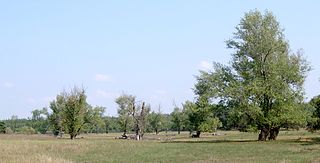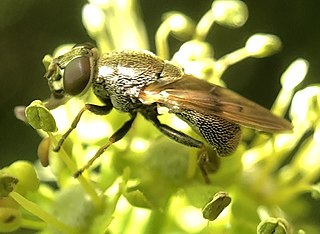
Sambucus is a genus of flowering plants in the family Adoxaceae. The various species are commonly referred to as elder, elderflower or elderberry.

Populus nigra, the black poplar, is a species of cottonwood poplar, the type species of section Aigeiros of the genus Populus, native to Europe, southwest and central Asia, and northwest Africa.

Juglans nigra, the eastern American black walnut, is a species of deciduous tree in the walnut family, Juglandaceae, native to central and eastern North America, growing mostly in riparian zones.

Rhamphospermum nigrum, black mustard, is an annual plant cultivated for its dark-brown-to-black seeds, which are commonly used as a spice. It is native to cooler regions of North Africa, temperate regions of Europe, and parts of Asia.

Sambucus nigra is a species complex of flowering plants in the family Adoxaceae native to most of Europe. Common names include elder, elderberry, black elder, European elder, European elderberry, and European black elderberry. It grows in a variety of conditions including both wet and dry fertile soils, primarily in sunny locations. The plant is widely grown as an ornamental shrub or small tree.

Myolepta is a cosmopolitan genus of hoverflies most closely related to the genus Lepidomyia

Sericomyia transversa , the Yellow-spotted Pond Fly , is an uncommon species of syrphid fly observed in northeastern North America.. Hoverflies can remain nearly motionless in flight. The adults are also known as flower flies for they are commonly found on flowers, from which they get both energy-giving nectar and protein-rich pollen. The larvae of this genus are known as rat tailed maggots for the long posterior breathing tube.
Periscelis is a genus of flies in the family Periscelididae. There are about 15 described species in Periscelis.

Myolepta strigilata, the Scaled Pegleg, is an uncommon species of syrphid fly observed in the eastern and central United States. Hoverflies can remain nearly motionless in flight. The adults are also known as flower flies for they are commonly found on flowers, from which they get both energy-giving nectar and protein-rich pollen. The larvae of this genus have been found in rot holes of deciduous trees.
Chromolepida is a genus of stiletto flies in the family Therevidae. There are about five described species in Chromolepida.

Ceriana abbreviata , the Northern Wasp Fly , is a rare species of syrphid fly observed across North America and Canada. Hoverflies can remain nearly motionless in flight. The adults are also known as flower flies for they are commonly found on flowers, from which they get both energy-giving nectar and protein-rich pollen. The adults are wasp mimics. The larvae feed on the sap of tree wounds.

Sericomyia lata , the White-spotted Pond Fly , is a common species of syrphid fly observed across North America, concentrated in the east. Syrphid flies are also known as Hover Flies or Flower Flies because the adults are frequently found hovering around flowers from which they feed on nectar and pollen. Adults are 11.6–15.2 mm (0.46–0.60 in) long and black with large white abdominal spots. The larvae of this genus are known as rat tailed maggots for the long posterior breathing tube.
Chrysosyrphus latus , the Variable Wrinklehead, is a rare species of syrphid fly observed in the eastern United states and widespread in Canada. Hoverflies can remain nearly motionless in flight. The adults are also known as flower flies for they are commonly found on flowers, from which they get both energy-giving nectar and protein-rich pollen. The larvae are unknown.
' Paragus angustifrons, the Narrow-faced Grass Skimmer, is an uncommon species of syrphid fly observed throughout North America. Hoverflies can remain nearly motionless in flight. The adults are also known as flower flies for they are commonly found on flowers from which they get both energy-giving nectar and protein-rich pollen. The larvae have been reared from Aphis spiraecola and Aphis spiraephila.

Parhelophilus flavifacies , the Black-legged Bog Fly, is a rare species of syrphid fly observed in the Eastern United States and Canada. Hoverflies can remain nearly motionless in flight. The adults are also known as flower flies for they are commonly found on flowers, from which they get both energy-giving nectar and protein-rich pollen. The larvae are the long tailed "rat-tailed" type.

Syrphus knabi, the Eastern flower Fly, is an uncommon species of syrphid fly observed in the eastern United States and Canada. Syrphid flies are also known as Hover Flies or Flower Flies because the adults are frequently found hovering around flowers from which they feed on nectar and pollen. Adults are 7.2–12.9 mm (0.28–0.51 in) long. The larvae are predators of a variety of aphids in trees.

Myolepta varipes , the Orange-banded Pegleg , is an uncommon species of syrphid fly observed in the eastern half of the United States. Hoverflies can remain nearly motionless in flight. The adults are also known as flower flies, for they are commonly found on flowers from which they get both energy-giving nectar and protein-rich pollen. The larvae of this genus are found in the rot holes of deciduous trees.
Heringia salax , the Eastern Smoothleg Fly, is a fairly common species of syrphid fly observed in many locations across North America. Hoverflies can remain nearly motionless in flight. The adults are also known as flower flies for they are commonly found on flowers from which they get both energy-giving nectar and protein rich pollen. The larvae are predators on aphids.

Eristalis saxorum, the Blue-polished Drone Fly, is an uncommon species of syrphid fly found along the Eastern United States. Hoverflies get their names from the ability to remain nearly motionless while in flight. The adults are also known as flower flies for they are commonly found around and on flowers, from which they get both energy-giving nectar and protein-rich pollen. The larvae are aquatic filter-feeders of the rat-tailed type. The larvae of this species have not been identified. Little is known about this uncommon species which flies from mid-March to late October.
Pipiza nigripilosa, the pale-haired pithead, is a common species of hoverfly in the eastern United States which can remain nearly motionless in flight. The adults are also known as flower flies for they are commonly found on flowers, from which they eat energy-giving nectar and protein-rich pollen. Its larvae are aphid predators.













